This post and the photos within it may contain affiliate links. If you purchase something through the link, I may receive a commission at no extra charge to you.
In this tutorial, I will teach you how to write calligraphy with a normal pen.
Faux calligraphy (also known as fake calligraphy) is a fun and simple way to practice calligraphy.
The best part is that you can do faux calligraphy with any sort of writing tool that you have.
In this tutorial, I will show you everything you need to get started, and I’ve also included some worksheets to help you with your further practice.
Here is a quick overview of what you will be learning –
- What is faux calligraphy?
- What tools do I need for faux calligraphy
- The 3 core rules for faux calligraphy
- Faux calligraphy in 5 simple steps
- FREE downloadable practice sheets!
- Final words
Without any further ado, let’s get started!
What is faux (fake) calligraphy
Faux calligraphy, or also known as fake calligraphy is a technique of imitating the look of calligraphy by using any kind of writing tool. Hence the name. The effect is created by adding an additional stroke to the downward strokes.
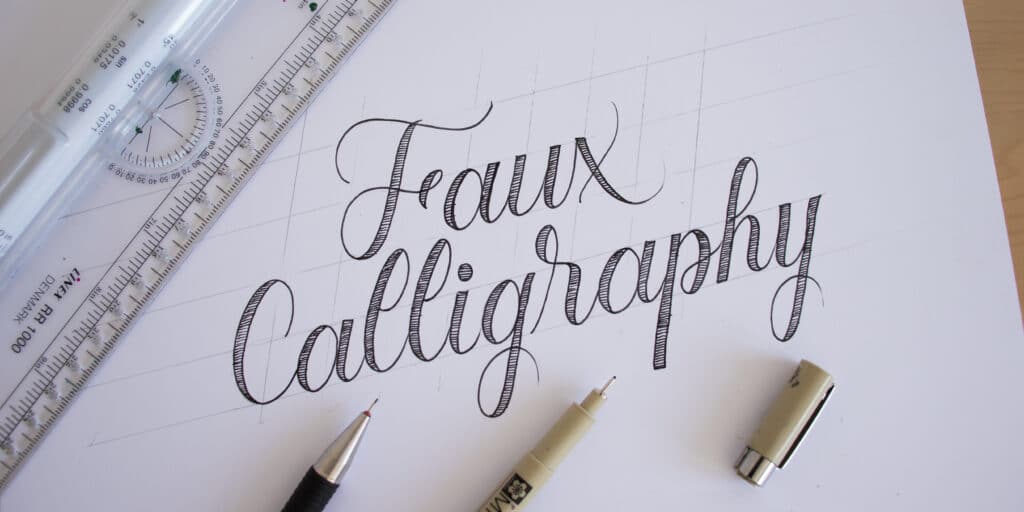
Let me give you a bit of context so you have a better understanding of the topic.
As I said several times in my previous articles, calligraphy is the art of beautiful writing, and depending on the script (style), it requires specific tools.
Faux calligraphy is simply a fun and easy way of imitating the look of these specific tools.
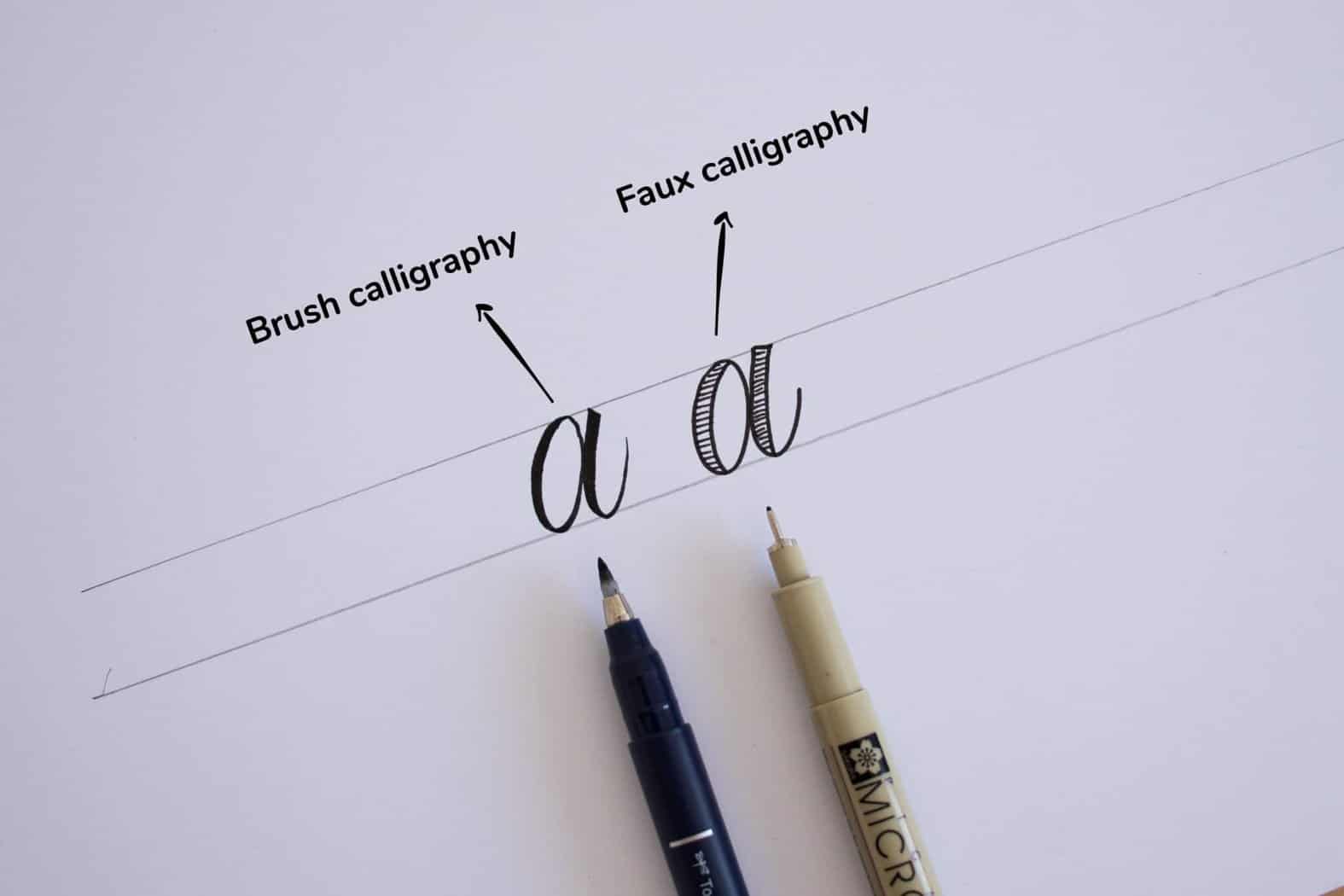
The best part,
Is that you can use any writing tool that you have!
Whether it’s a pencil, marker, fineliner, pen, chalk – you can use it to create faux calligraphy.
Faux calligraphy is also a great technique if you want to emulate the calligraphic look on surfaces where you can’t really use regular calligraphy tools.
Surfaces such as –
- Chalkboards
- Walls
- Wood
- Clothing
- Glass
- Etc.
On top of that, faux calligraphy is a great way for beginners to learn about the basic letter structure and the way they interact with each other.
That will make more sense once we get to the actual step by step tutorial part.
But first, let’s have a quick overview of the needed tools.
Tools needed for faux calligraphy
As mentioned earlier, one of the best parts about faux calligraphy is that you can do it with nearly any writing tool that you have.
For this tutorial, we will use a few additional items (besides just a pen) that will help us achieve better results.
Here is a list of items that I will use (links to amazon) –
- Paper – I am using the HP Premium, but I also recommend using a Rhodia dot pad.
- Rolling ruler – drawing guidelines can’t be more comfortable than this.
- Mechanical pencil – A pencil is a must tool for any lettering/calligraphy artist.
- Eraser – we all make mistakes…
- Fineliner – Sakura micron are my favorites, but you can use whatever you have or prefer.
- Pencil, or any other writing tool that you might have.
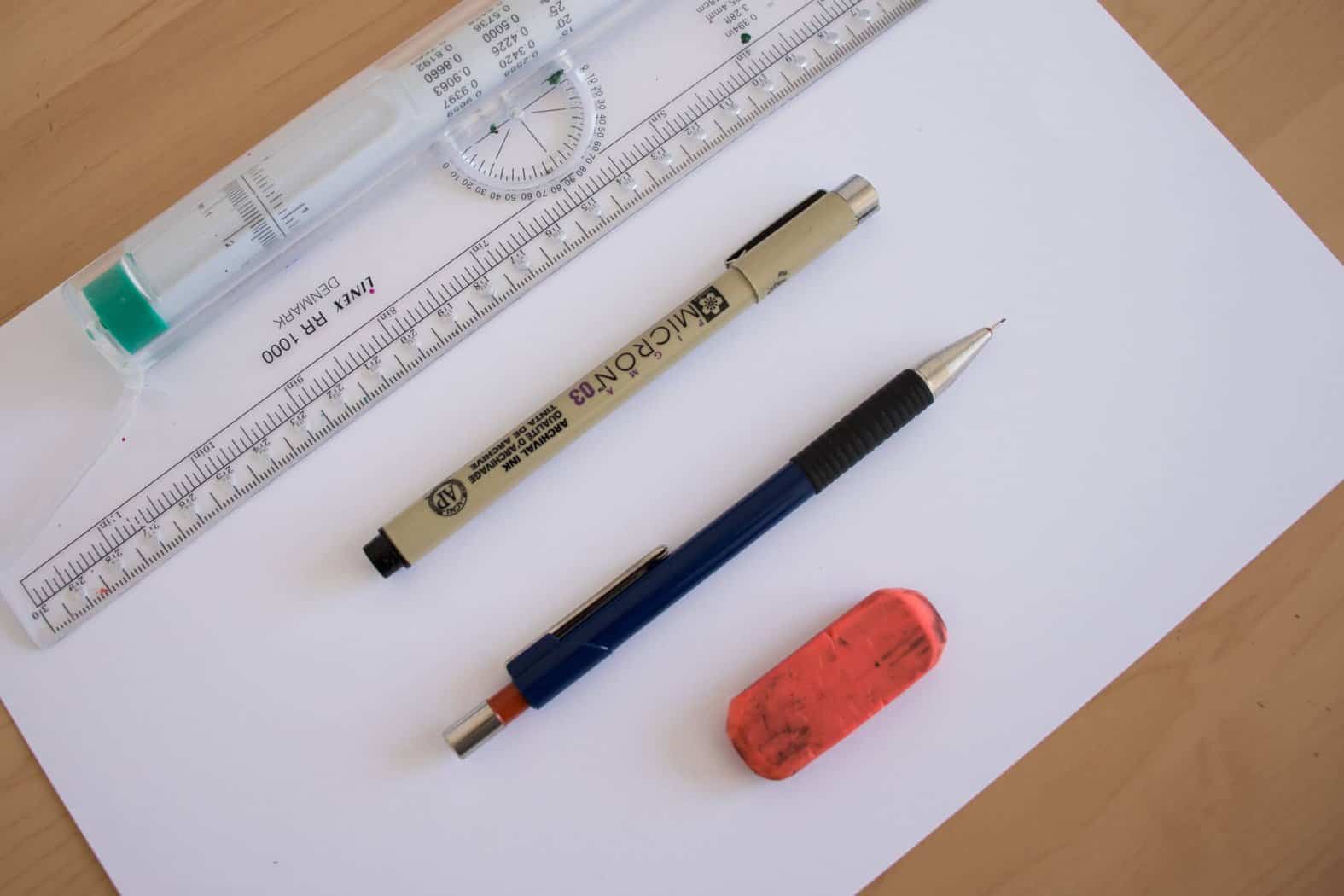
If you are wondering why I included the pencil and the ruler on the list,
Here is why –
We are going to use the pencil and the ruler for two essential elements in the process.
- Guidelines – No matter what style or technique you practice, guidelines are always helpful – especially if you are just a beginner. It takes you just a few seconds to draw a couple of lines with a ruler, and it helps to keep our letters nice and consistent.
- Sketching – often perceived as something tedious, sketching is an excellent way to prep your letters. I will show you how simple and effective sketching can be, and if you then decide to skip this step, it’s totally up to you. Just remember that graphite can be erased while ink can’t.
Ok, now that we covered the needed tools for faux calligraphy – it’s time to roll up our sleeves and get to work!
The 3 core rules for faux calligraphy
Before we jump right into the writing part, I feel it’s essential to cover a couple of fundamental rules – especially if you are just getting started.
The better you understand the basics, the easier it will be for you to learn, improve, and gradually expand your skills.
Remember – Your house is only as strong as It’s foundation!
To keep things simple, I will just mention 3 core rules that you should keep in mind when practicing faux calligraphy –
- Basic strokes
- Consistency
- Where to add the thick downstrokes – leaving enough space
1. Basic strokes
Writing calligraphy (at least this particular style) is a combination of upstrokes and downstroke motions.
The most important thing to always remember is –
Upstrokes are thin
Downstrokes are thick
Like so –
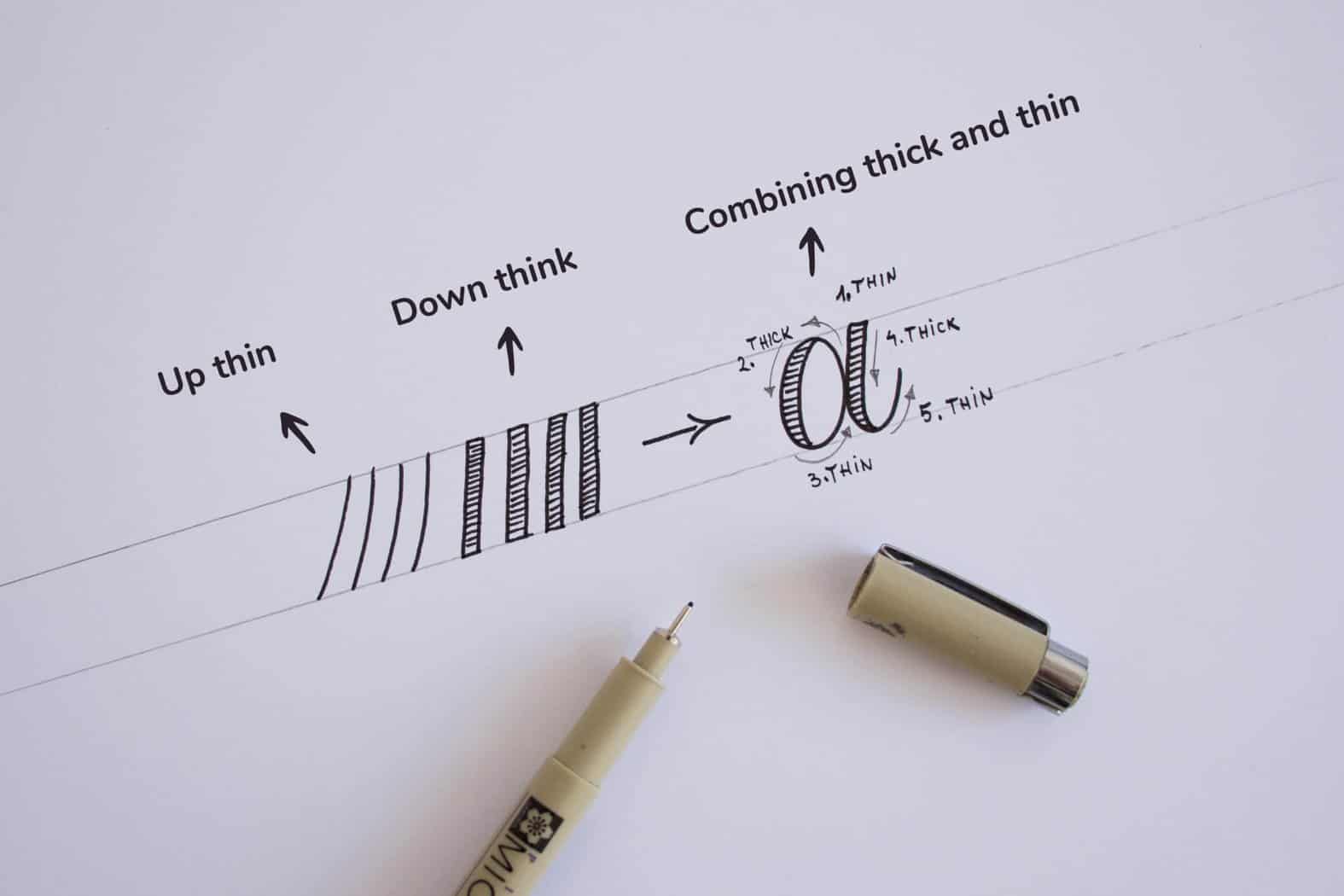
The best way to learn and practice calligraphy is by using the basic strokes.
There are 8 basic strokes that you can use to combine and form nearly every letter of the lowercase (minuscule) alphabet.
Using these basic strokes, we can achieve a much cleaner and more consistent look in our calligraphy.
I’ve already covered this concept more in-depth in my modern calligraphy guide, and I definitely recommend you check it out.
I also created a whole in-depth tutorial specifically for the basic calligraphy strokes and how to use them.
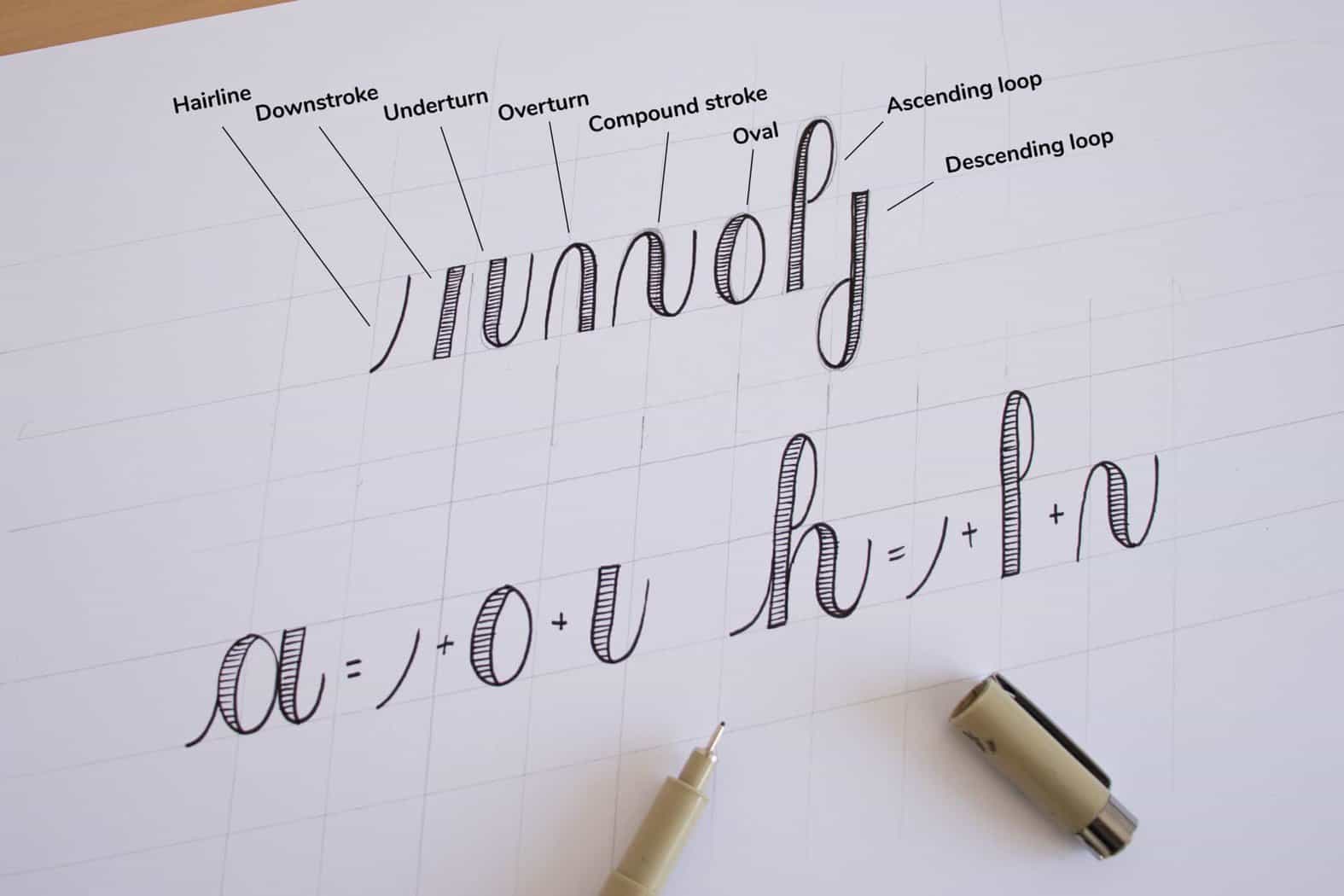
Here you can see an example of the basic strokes, and how to combine them in order to achieve different letterforms.
2. Consistency
Consistency is a crucial element for calligraphy.
In short, consistency makes the difference between good and lousy calligraphy – one that is pleasant to look at and one that it’s not.
Here is an example –
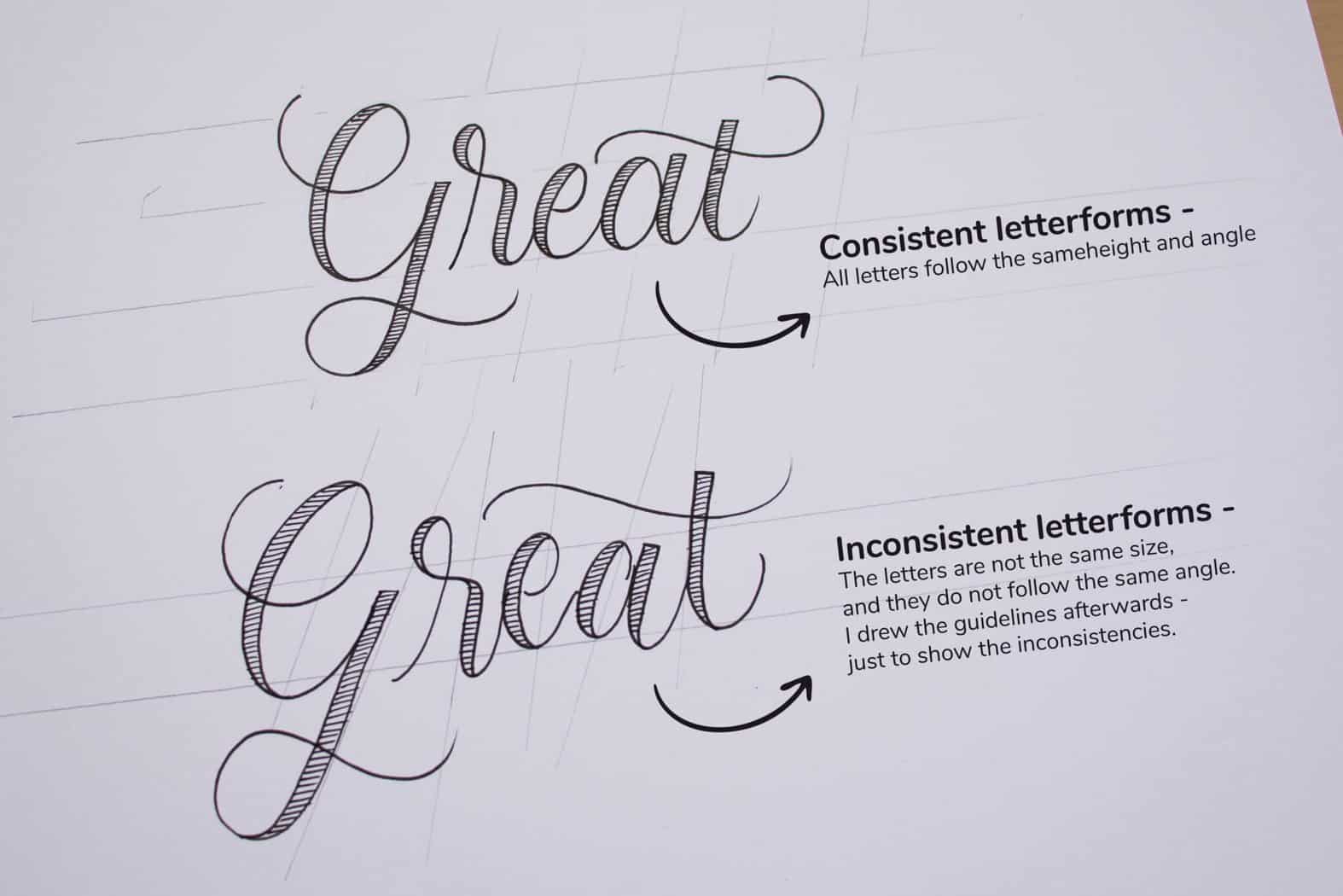
The word above – I firstly drew the guidelines using my rolling ruler and then laid down the letterforms.
The word below – I wrote the word without guidelines and then added the guidelines afterward. This is just to show the inconsistencies of the letters.
Sure, the basic strokes help us with consistency, but another super helpful way to achieve consistency is by using guidelines.
Guidelines will help you to keep your letters at the same height and angle.
I created a whole separate tutorial on calligraphy guidelines and how to use them.
Here is an example of guidelines and their terminology.
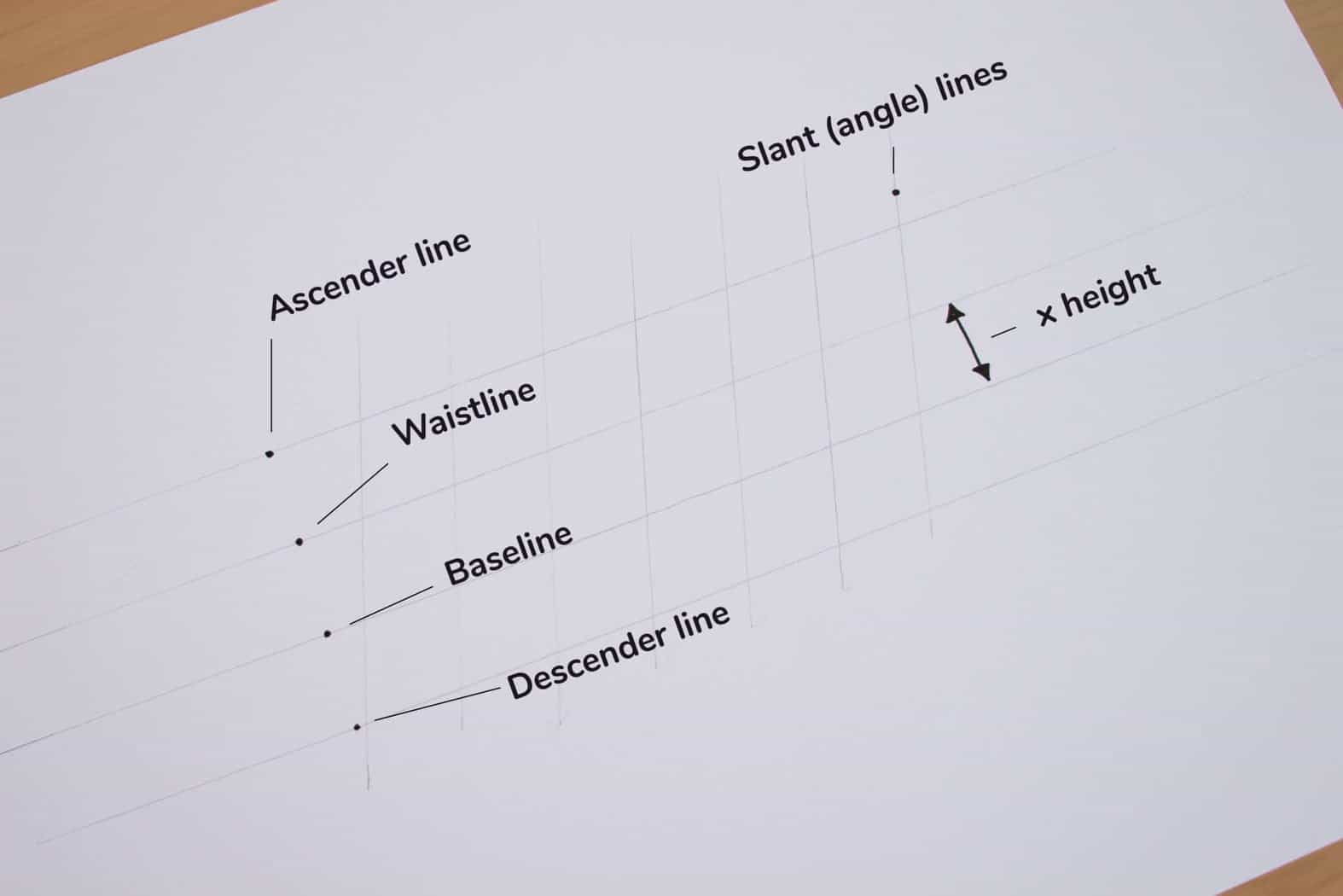
Another super important mention for consistency when it comes to faux calligraphy is to keep your down-strokes with the same thickness.
Of course, you don’t need to go crazy with mathematical precision.
Still, at the same time, you want to avoid a noticeable difference in the thickness of your downstrokes.
Here is an example –
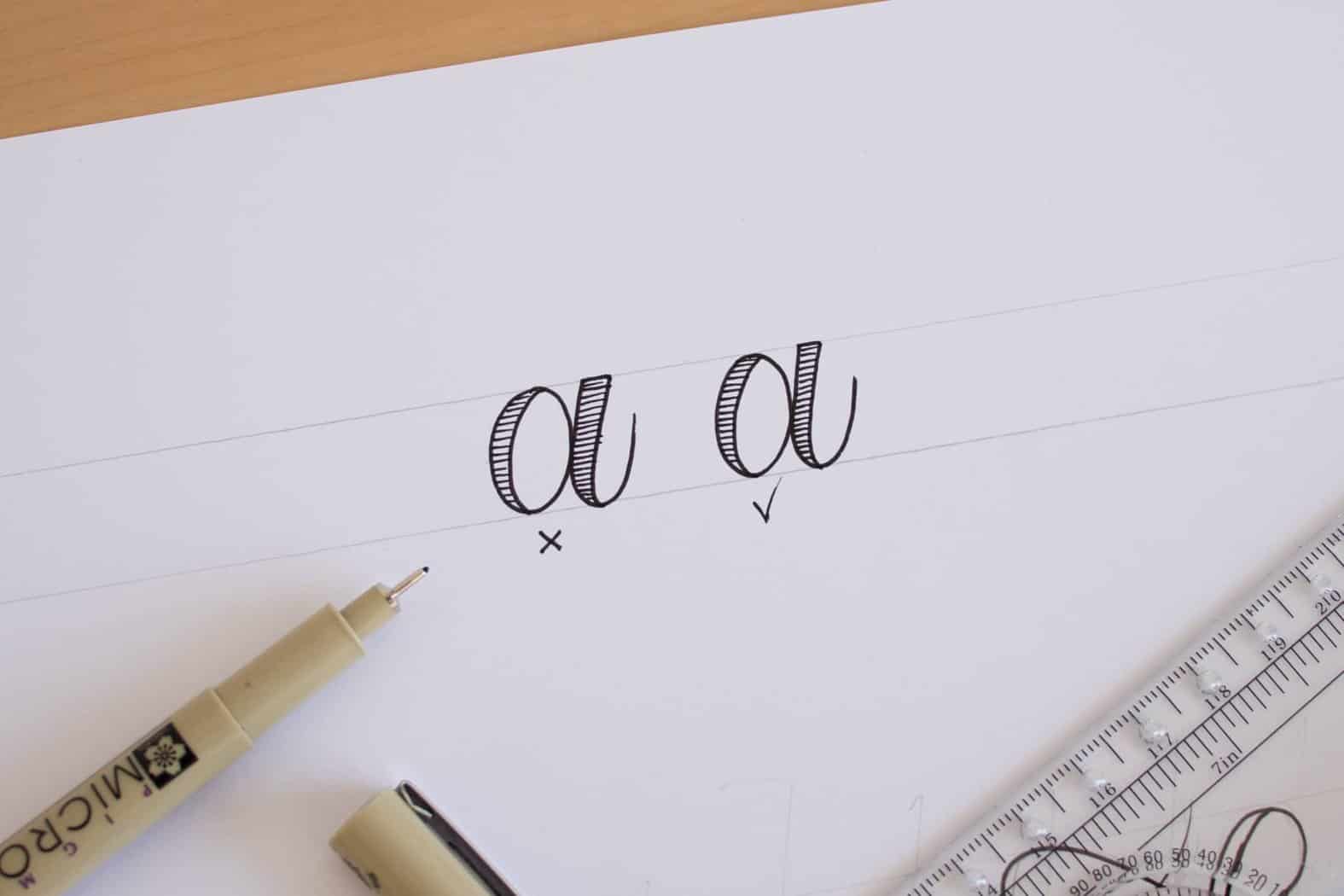
3. Where to add the thick downstrokes – leaving enough space
One particular thing I see beginners struggling with faux calligraphy is – adding the downstrokes.
You have to be mindful about which side you add your downstrokes, otherwise you end up with inconsistent spacing.
What I do and recommend is – always add the thickness to the inside part of your letters.
On some letters you may want to leave a slight gap (like the letter p in the example below) – but this isn’t a must.
Check out the example below –
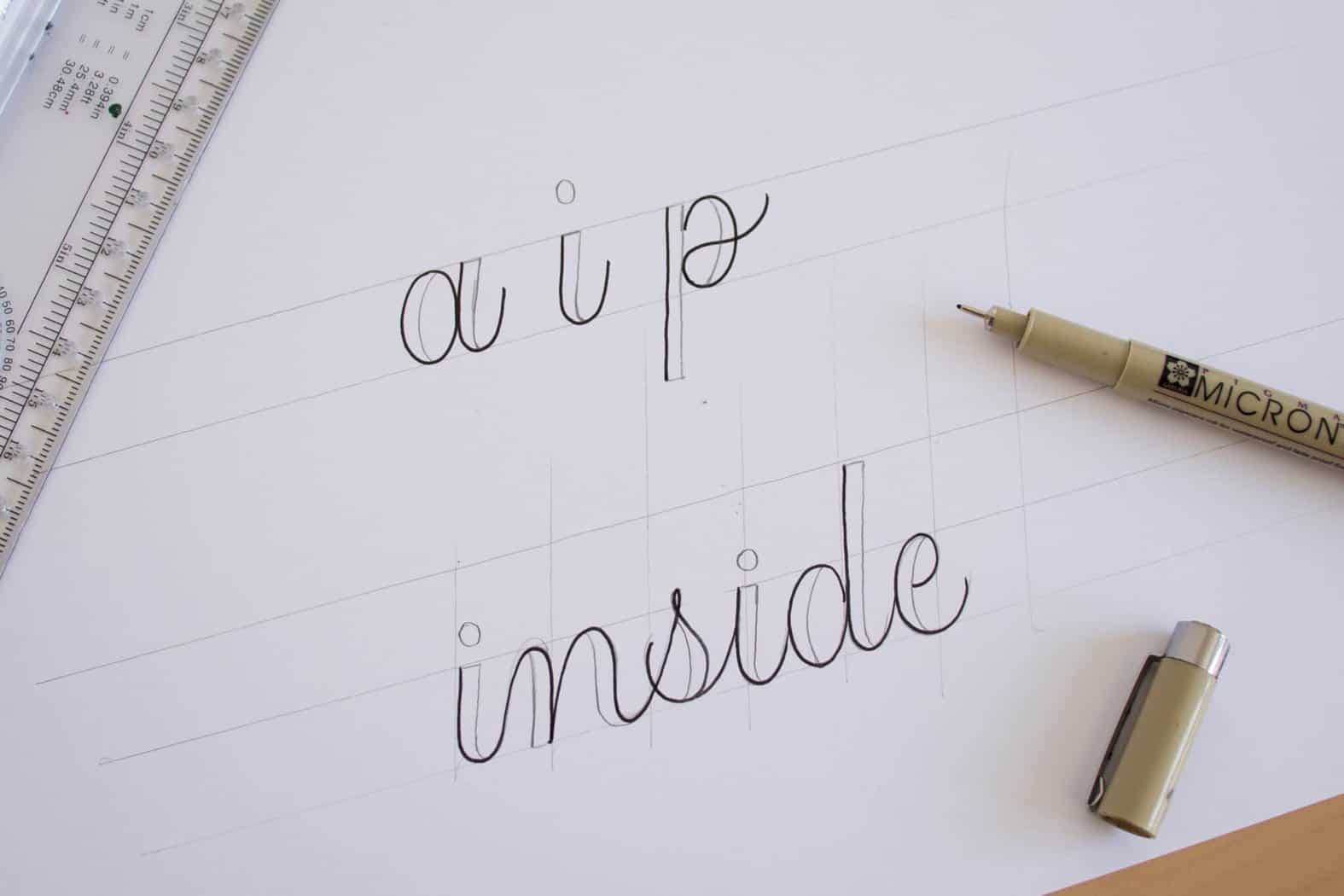
By always adding the thick part on the inside of the letters, we ensure consistent spacing between the letters.
Note – if you wish to add them on the outside, that’s totally fine as well. The important is that you are aware of spacing and consistency.
Faux calligraphy in 5 simple steps –
Step 1 – Draw your guidelines
For this example I will write out the word – Beauty
Grab your ruler and draw your guidelines like so –
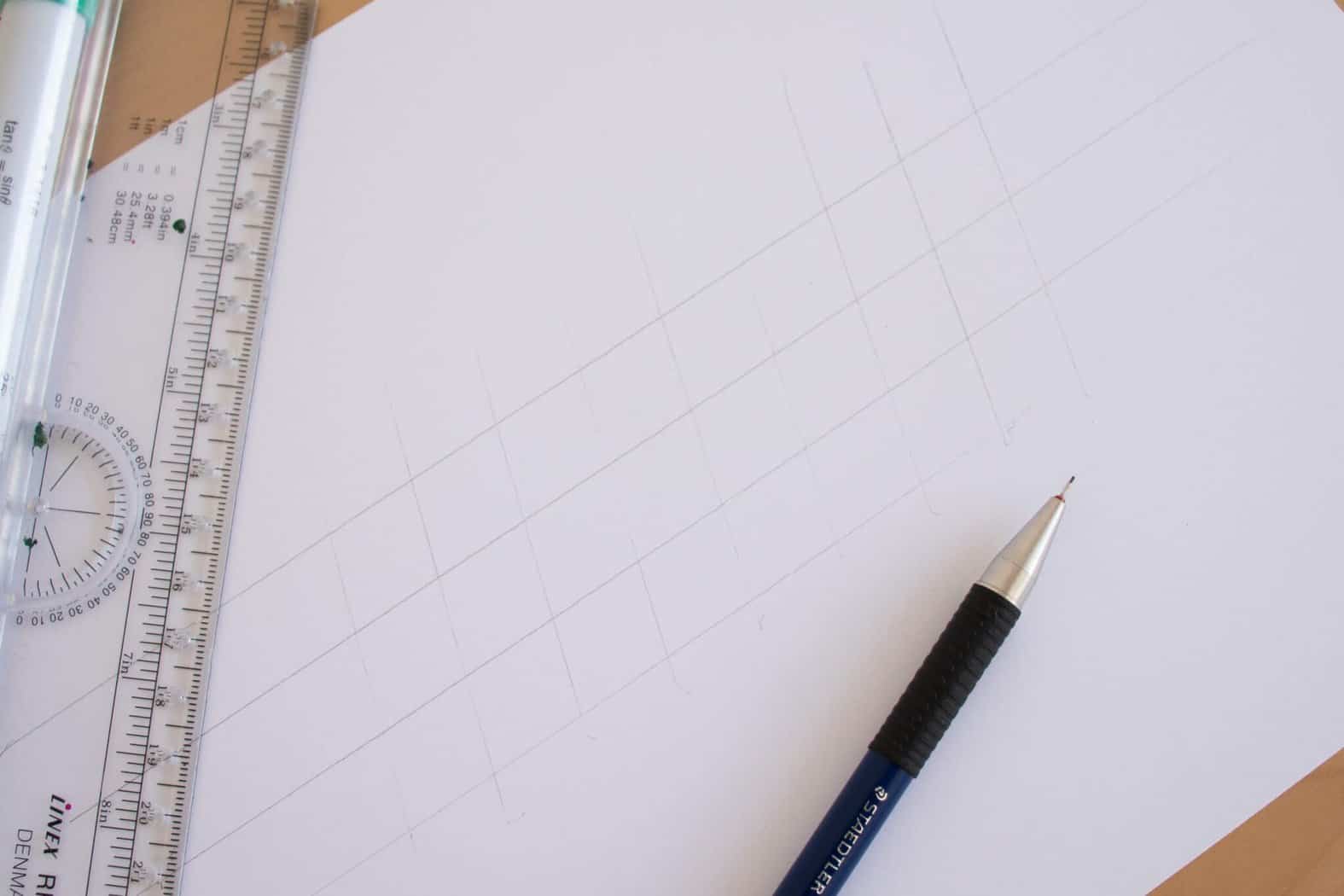
This is precisely why I like to use the rolling ruler – it makes this process so easy!
If you are wondering at what angle your slant lines should be – you decide!
What matters is that your letters actually follow these guides.
Step 2 – Sketching time!
Quick note –
Sketching is purely optional. I recommend it because I believe it helps – especially if you are just getting started.
If you feel confident enough, you can grab a pen/marker straight away.
Using the mechanical pencil (or just a regular pencil) and the basic calligraphy strokes, start writing your word.
For now, the word will be in a monoline, and as mentioned earlier, make sure to leave enough space for your downstrokes.
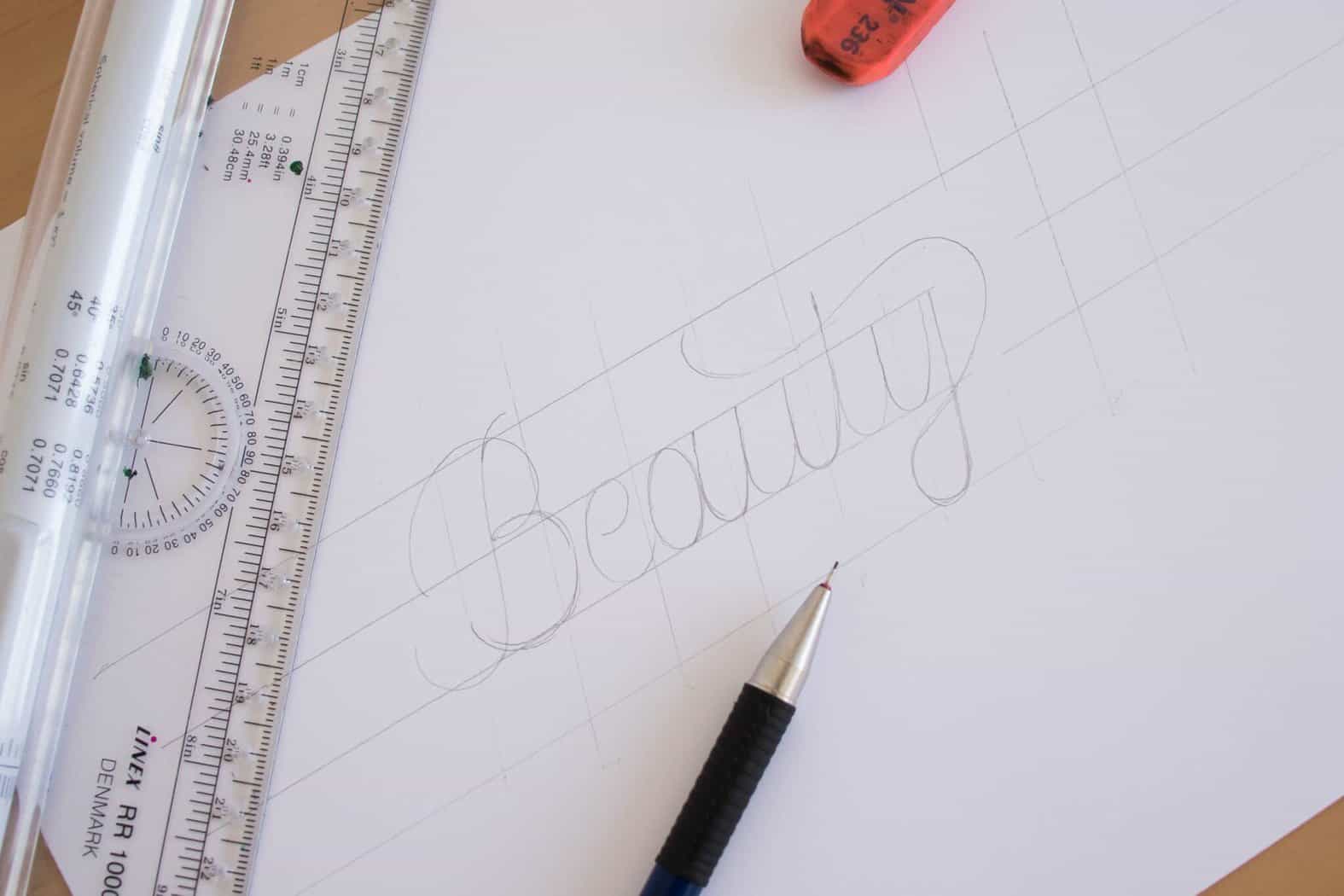
Don’t rush it, it’s not a race.
It’s better to take your time and get it right.
Try to be mindful about your guidelines – maintain the same heights and angles.
If you make a mistake, it’s all good!
That’s why we use the pencil first, so we can fix these mistakes and get it right.
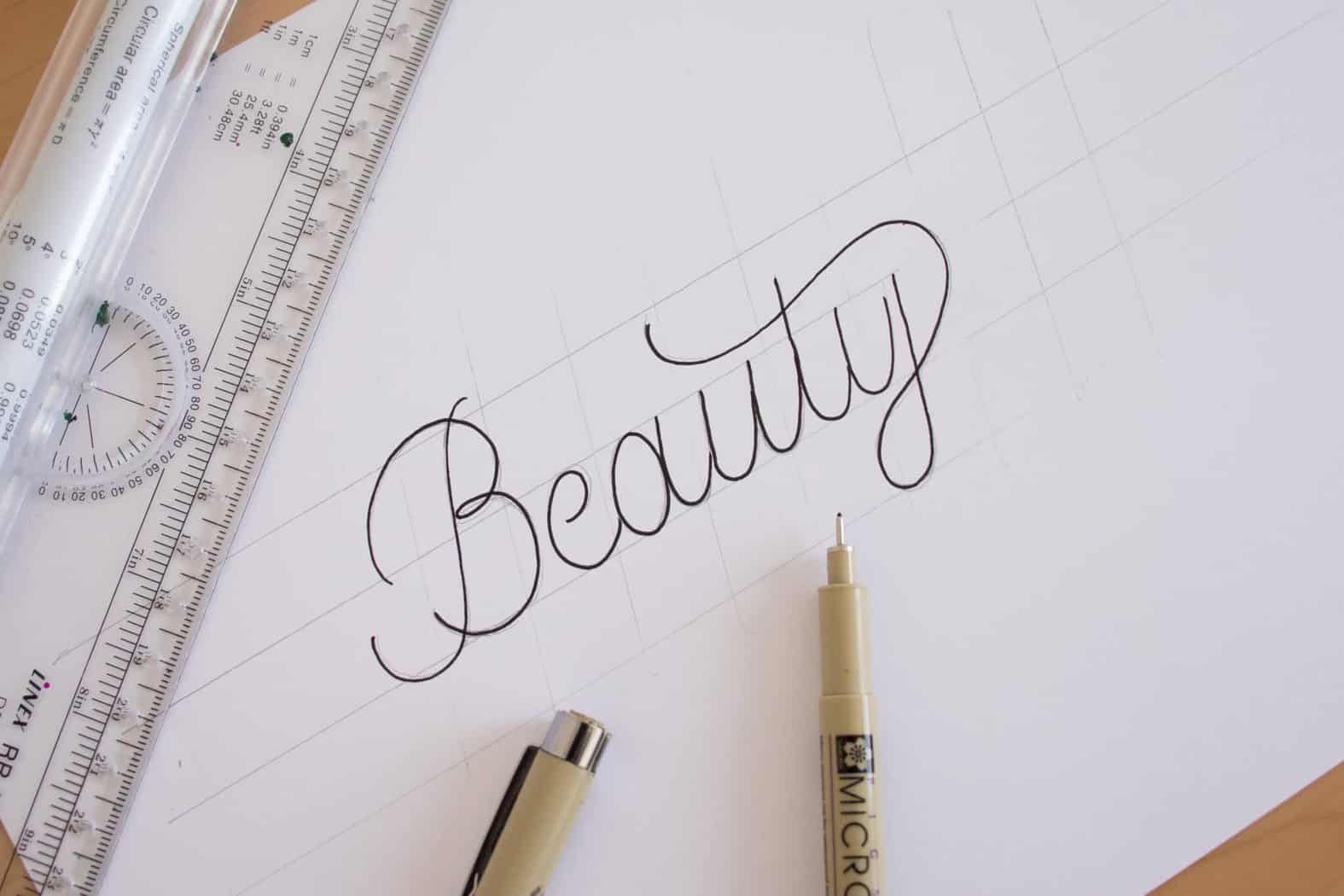
Step 3 – Identify your downstrokes
Remember what we previously said –
Up is thin while down is thick.
We also said to add the downstrokes on the inside part of each letter.
That being said, on each downstroke, I will add weight, like so –
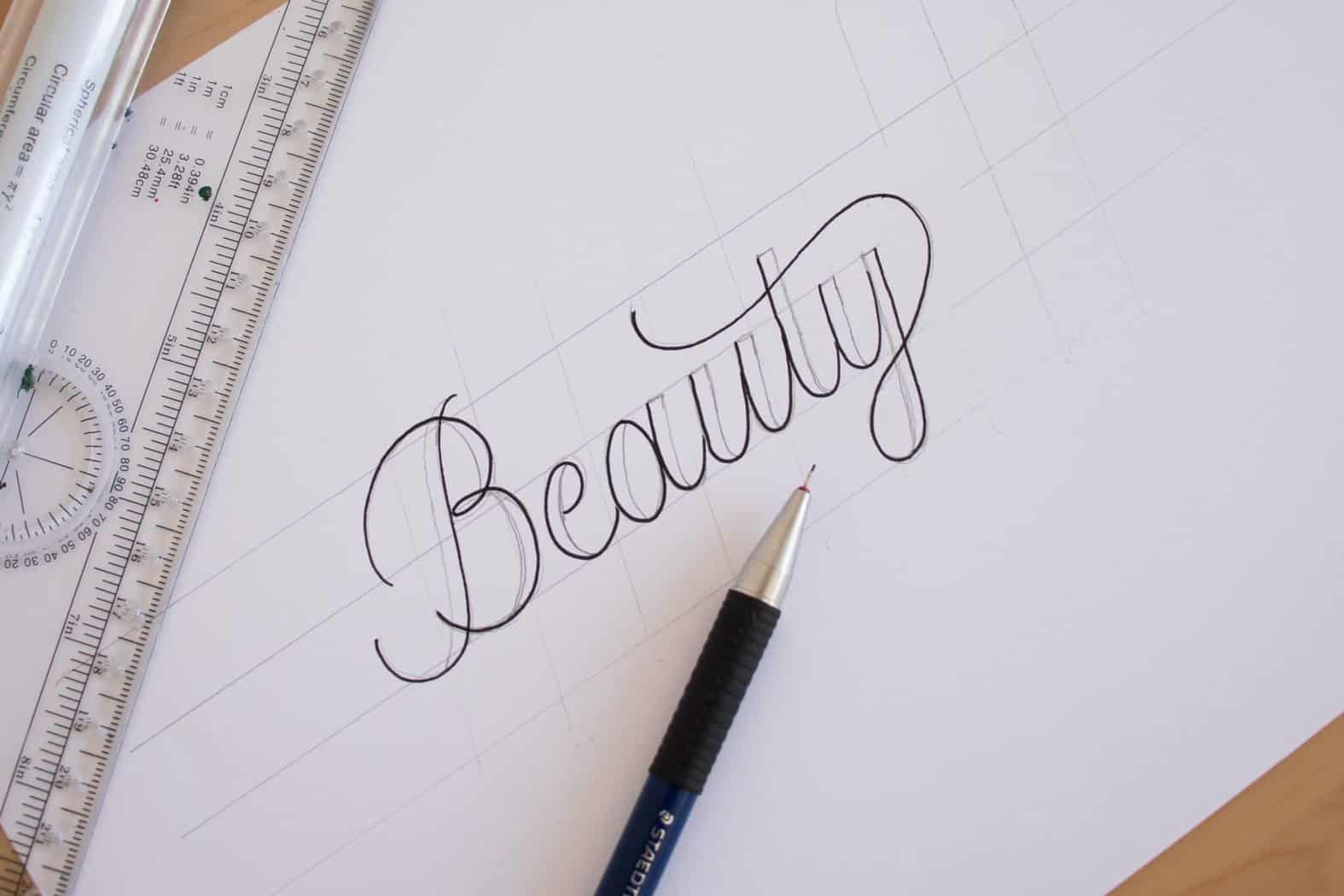
Step 4 – Ink it and fill it
Now that we have our sketch ready, it’s time to ink it and fill the downstrokes.
If it doesn’t look perfect the first time, don’t be surprised.
This is something that requires consistent practice.
If you want some tips on how to improve your outlining and inking, I wrote a separate article for that, and you can check it out here.
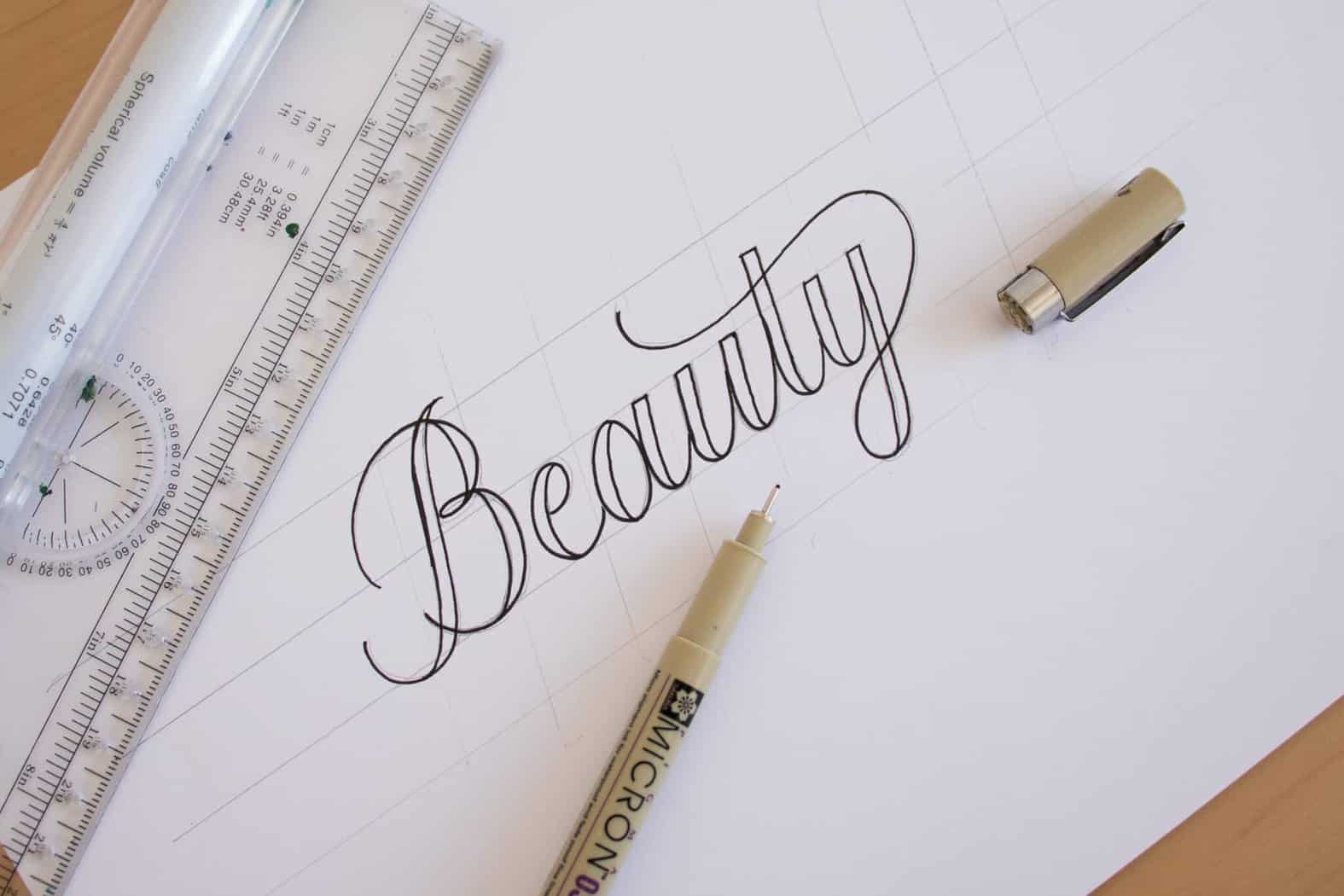
Step 5 – erase the pencil marks
Give it a few minutes for the ink to completely dry off.
This way, you avoid getting those pesky ink smudges all over your fresh piece.
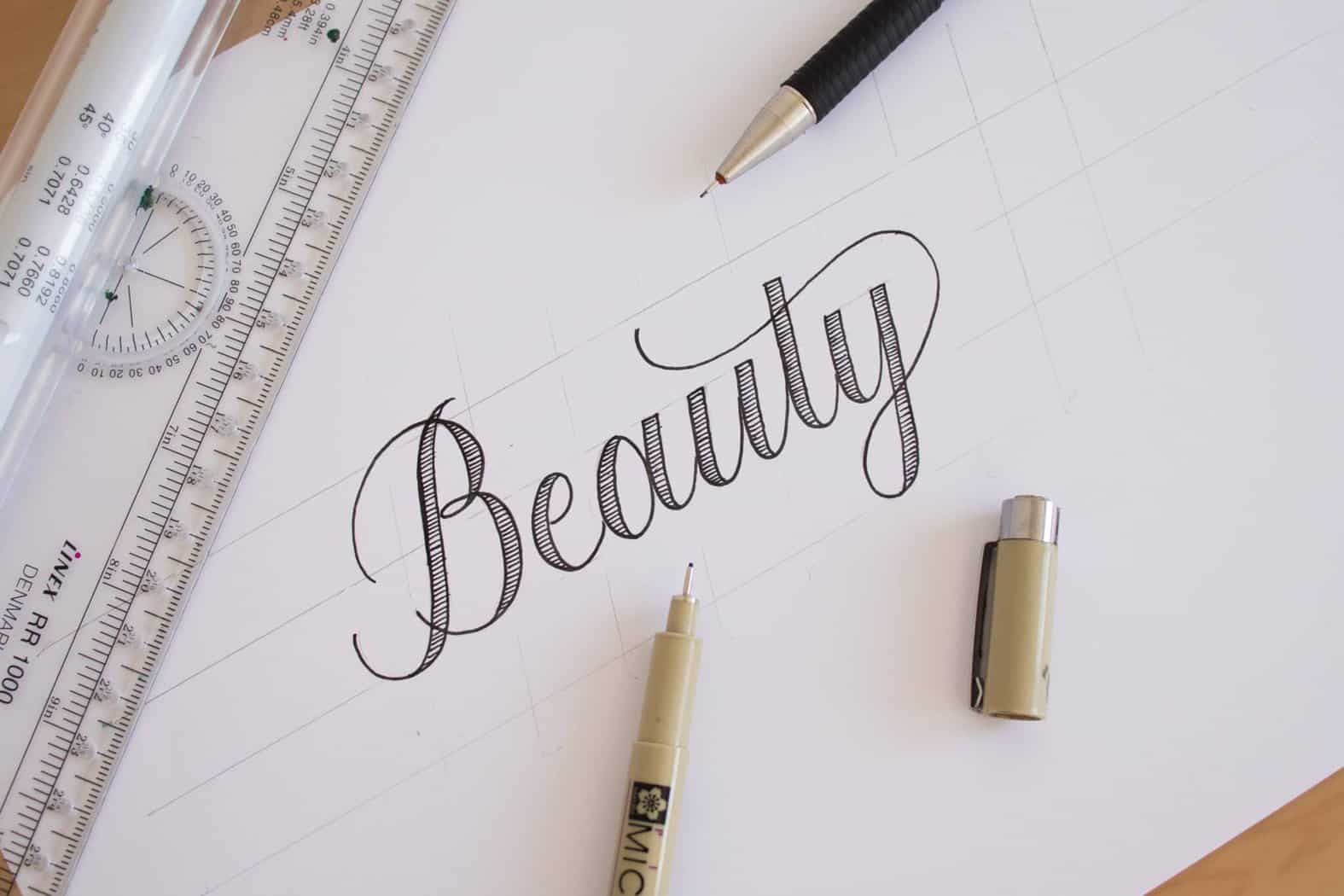
I really like to fill my letters with this line pattern.
You can do the same, fill them with a solid color or try something totally different.
That’s it!
Faux calligraphy in a nutshell!
Once you get more comfortable with the very basics, you can start tweaking things and even develop your own style.
But remember, to make better and faster progress – you must have a good foundation!
Before we wrap things up for this tutorial, here are a couple of bonus tips.
Bonus tips for faux calligraphy beginners
1. Get yourself a proper work environment.
If you plan to practice while lying on the couch and watching Netflix – don’t have high expectations.
You need to sit with the correct posture on a table with the proper height along with adequate light.
When it comes to getting a proper setup, I always recommend everyone to watch these three videos on YouTube by my friend Paul.
I HIGHLY recommend you watching them!
This is essential for all calligraphy styles and techniques.
2. If you are starting out stick to shorter single words
A common mistake I continuously see beginners make is that they tend to rush too much.
After a couple of attempts, they immediately jump straight to long quotes, layouts, flourishing, details, etc.
You gotta slow down, chief!
I’m not saying that you should never try to practice anything besides the basics.
At the same time, if you only practice for 30 minutes a day, you shouldn’t spend most of your practice time on trying to create something you are still not ready for.
Take it one step at a time and enjoy the process – I guarantee that you will see much better and faster results if you gradually expand your skills.
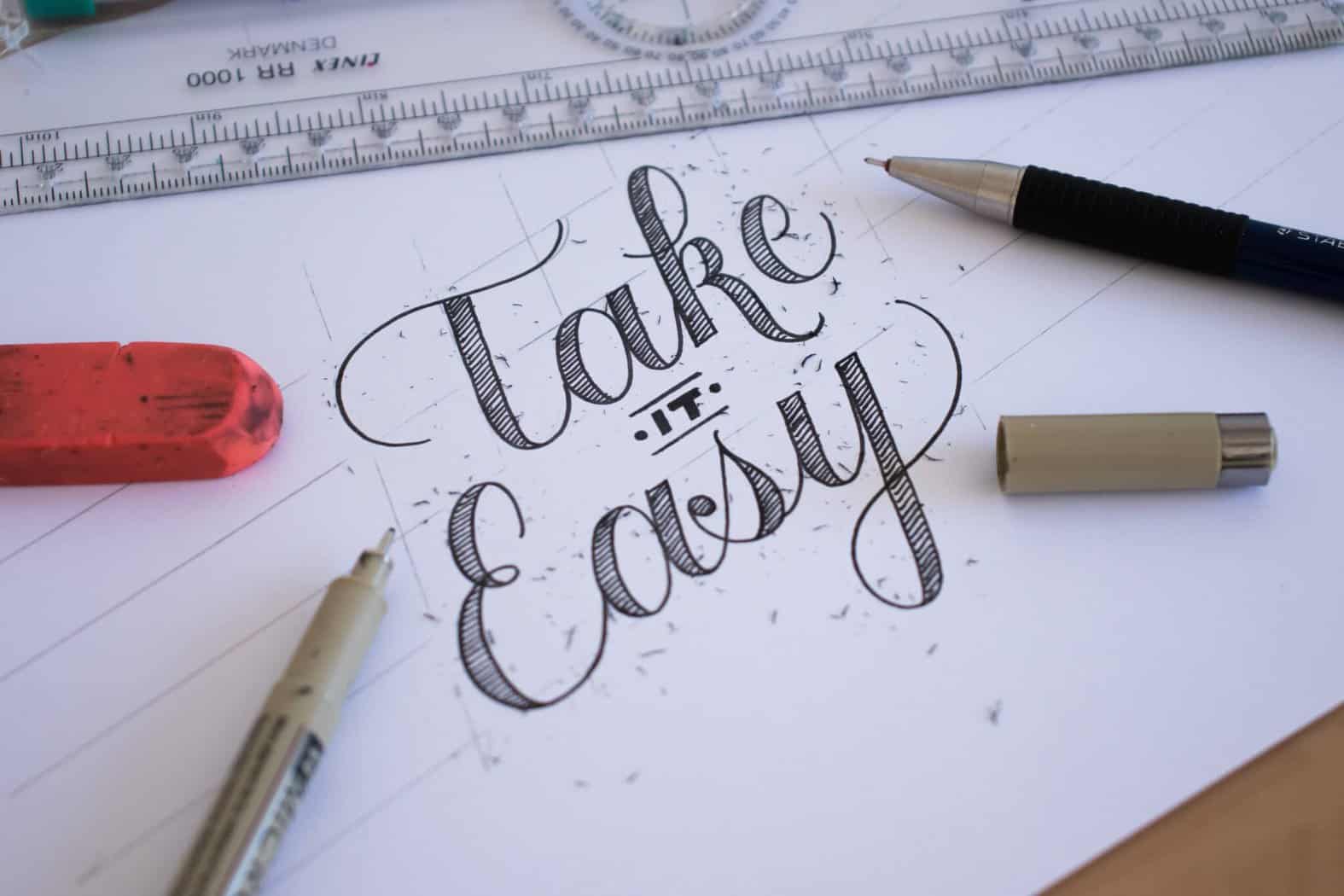
3. Practice, practice, practice…. And more practice!
You’ve probably heard it so many times already, but it’s true!
The more you practice, the better you will become.
However, consistent practice will beat intensive practice pretty much always.
By that, I mean that it’s better to practice every single day even if it’s just 15-20 minutes than practicing twice a week for two hours.
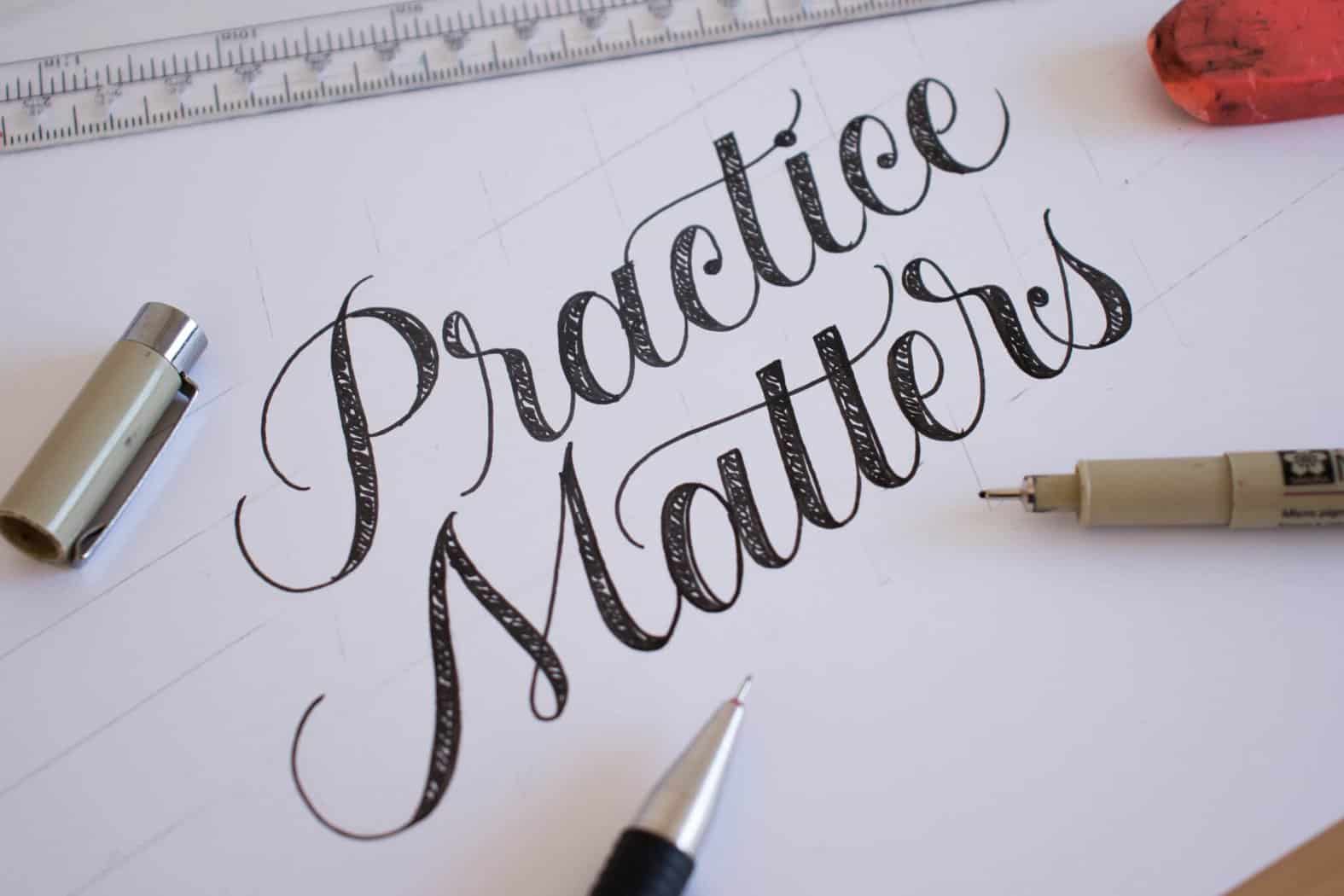
3. Practice is important but…
It is obvious that by practicing you will improve, however, the way you practice makes a tremendous difference.
Don’t just spend your practice sessions on scribbling randomly on a piece of paper.
Here is how i usually structure my practice sessions (it varies depending on styles and techniques) –
- Warm up with drills. Getting into the zone. The fewer distractions you have, the better.
- Pick a word or a phrase (quote) and only write that for a practice session. I make several attempts and sketches before choosing the final one.
- Create a final piece. I find this step crucial. By creating a final piece, you really push yourself to a whole different level. It puts you in a high-focused state of mind, and you give it your best shot. Of course, you keep each piece for future comparison.
- Analyze your work. Try to be critical to yourself even if you believe you did great. There is always room for improvement and by analyzing your work you can pinpoint your weaknesses and improve them in your next practice session.
This is of course, a very brief overview, and I will make sure to write a separate post for it.
FREE Downloadable Faux Calligraphy Worksheets
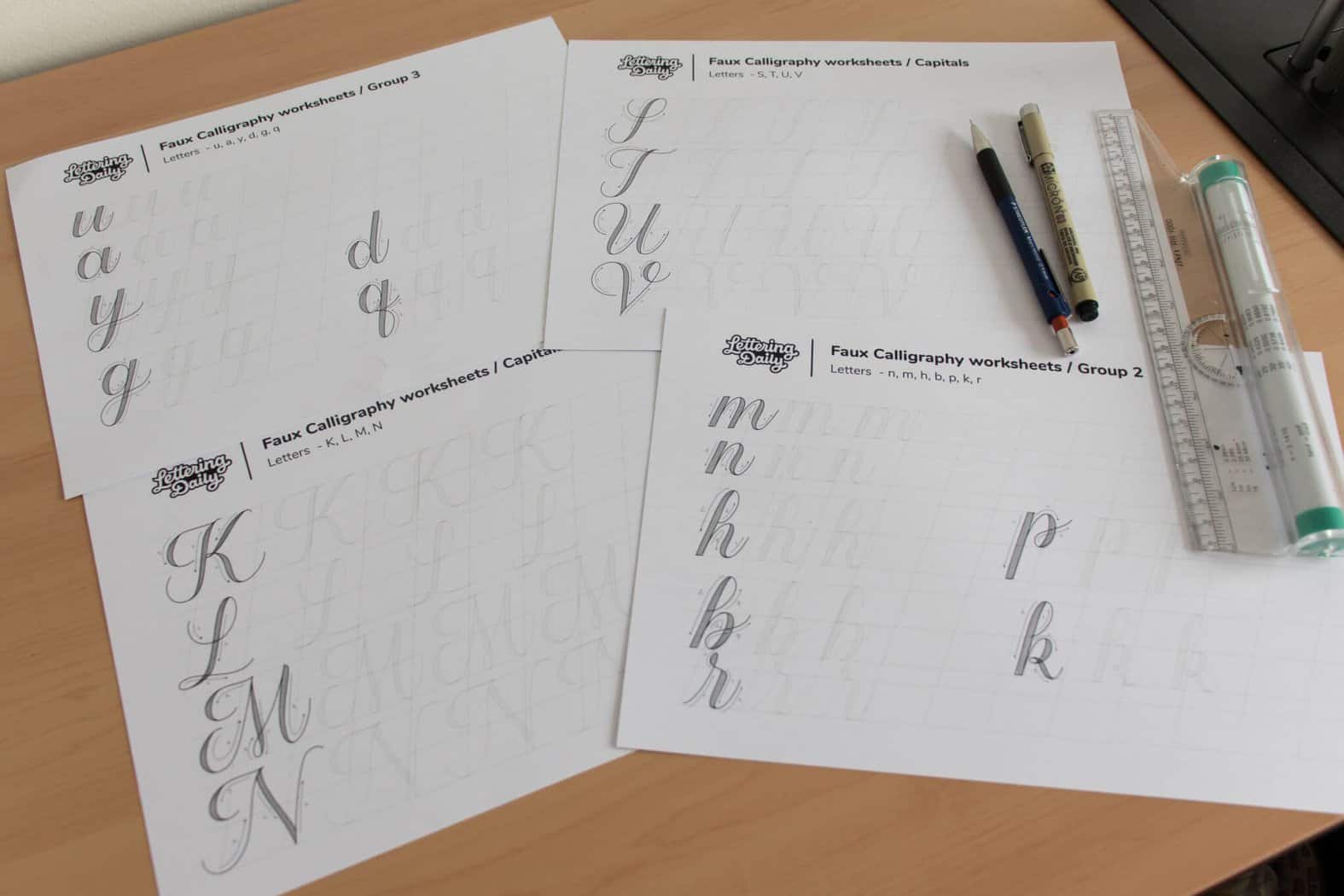
I created free printable worksheets so you can practice Faux calligraphy by yourself.
They include –
- Faux calligraphy capitals
- Faux calligraphy minuscules (lowercase)
- An empty sheet with guidelines for word practice
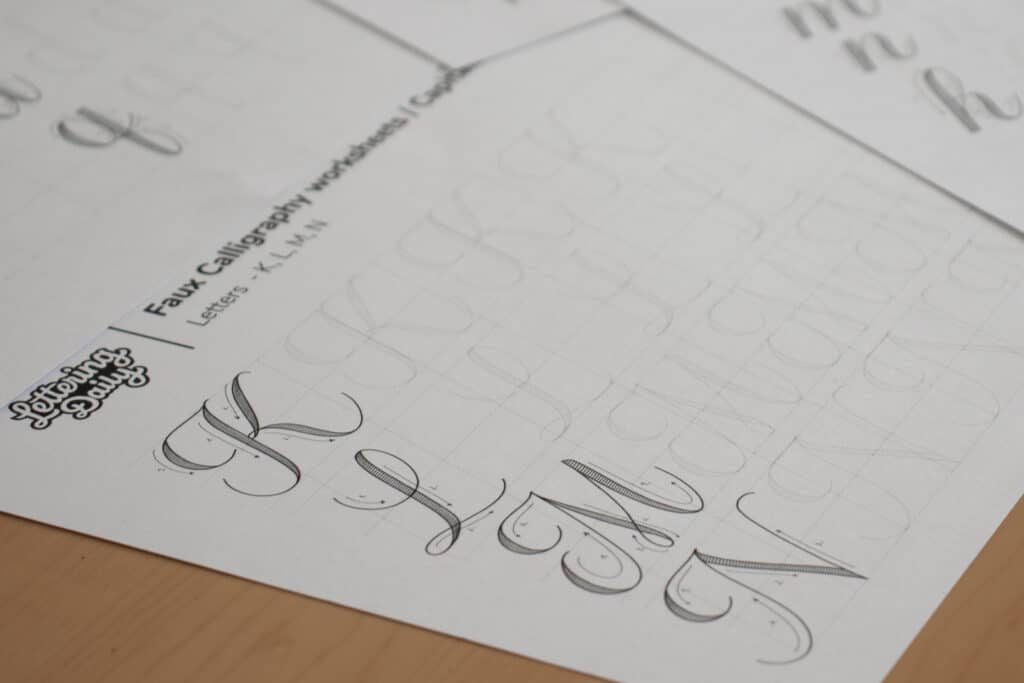

Drop your email below, follow the instructions, and you will receive instant access to all of the worksheets inside the Lettering Crate.

Stay updated with my tutorials and get instant access to the Lettering Crate –
A growing library of free lettering & calligraphy resources that includes –
FINAL WORDS
There you have it folks!
Faux calligraphy for beginners 🙂
To learn more about the various calligraphy styles, check out this article.
I hope that this tutorial managed to shed some light on the subject.
Remember – a house is only strong as it’s foundation!
Stick to the basics, be consistent and mindful about your practice and I promise – you will make progress!
If you some questions or you need some help you can always reach out to me.
However, I would highly recommend you join our official Facebook group.
It’s a place where you can –
- Share your work
- Get constructive feedback
- Network with fellow lettering & calligraphy artists
- Ask specific questions about lettering & calligraphy
- Much more!
Thank you for checking this tutorial out, and until the next time –
Stay AWESOME!
Pin me!
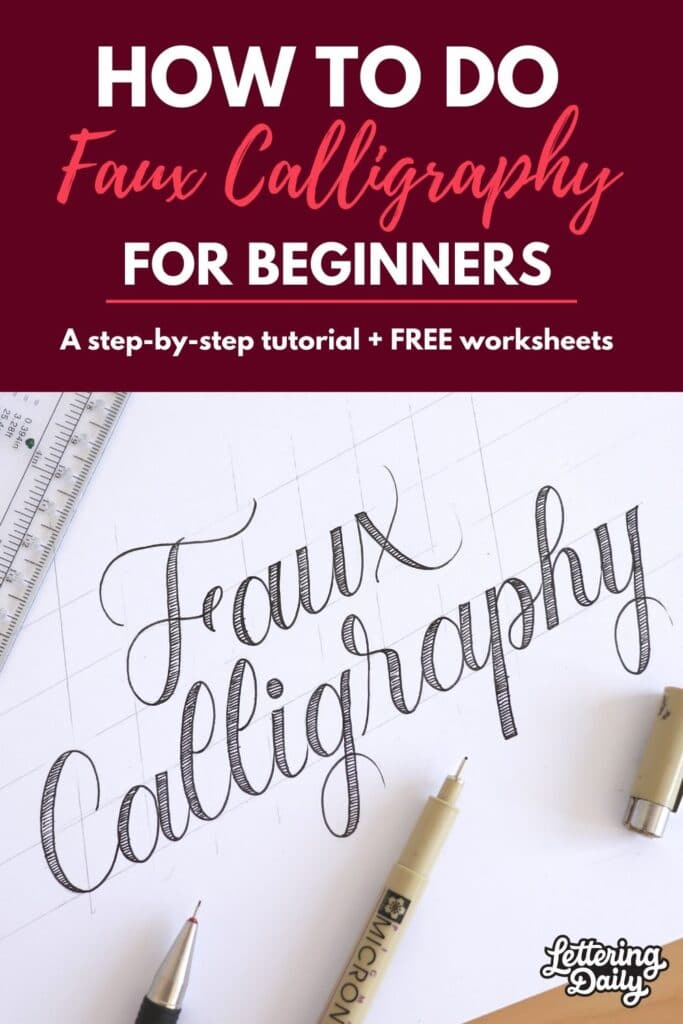
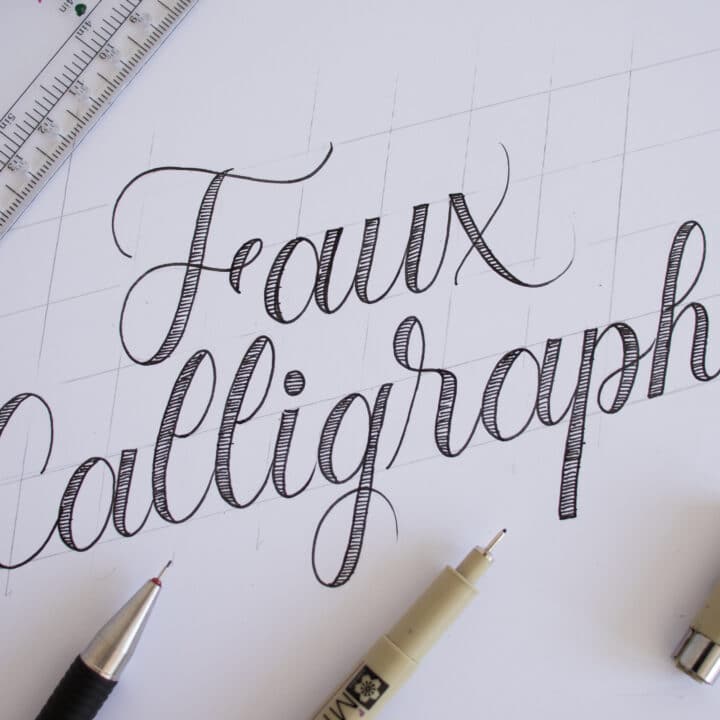
How To Do Faux Calligraphy
In this tutorial you will learn everything you need to get started with Faux Calligraphy.
Materials
Tools
Instructions
- Using the rolling ruler and the pencil, start drawing your guidelines. Like so -
- Using the pencil along with the basic calligraphy strokes, write down your letters. Try to keep a light hand so it will be easier to erase it later. For now keep it in a monoline style, as we will add the weight later on.
- Using the Sakura Micron, go over the pencil sketch.
- Now that we have our base laid down, it's time to identify our downstrokes. As mentioned in the tutorial it's best to add them consistently to the same side. I choose to do that on the inside part of the letters. This way I will be sure that all my letters are consistent. For now i will add the downstrokes using the mechanical pencil, like so -
- Take your pen and go over the pencil marks.
- Fill your letters and delete the pencil marks. I really like adding this line pattern to my letters. You can do the same, or you can do something totally different. There you have it, folks, Faux calligraphy in a nutshell 🙂
About the author

Hey, I’m Max Juric, and I’m deeply passionate about calligraphy and hand lettering.
I’ve spent years honing my skills in the art of lettering, working with hundreds of clients from all over the world on design projects such as logotypes, branding, custom lettering, murals, and more.
But my journey doesn’t end there. I’ve also dedicated myself to sharing my knowledge and expertise with others, creating a wealth of resources including tutorials, articles, and podcasts.
It’s been incredibly rewarding to see thousands of people engaging with my content each month. Knowing that I’m helping fellow enthusiasts grow and develop their skills makes me really happy.
Welcome to Lettering Daily, your hub for all things lettering and calligraphy. Whether you’re a seasoned pro or just starting out, I’m here to inspire and guide you on your lettering journey. Stick around, and let’s explore the world of letters together!

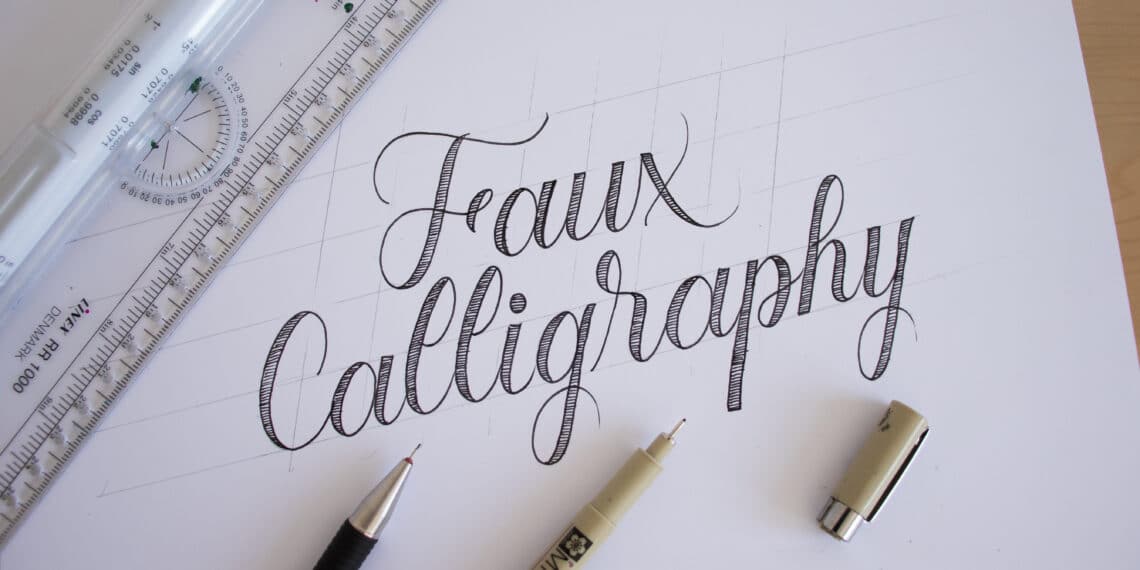
This was very helpful, I thought it was going to be a lot harder, but you made it look so easy. Thank You! 🙂
Super happy to hear that 🙂
Thank u for sharing such an amazing art
Thank you for the kind words.
Thank u
You’re welcome! 🙂
Awesome…
Thank you!
There’s noticeably a bundle to learn about this. I assume you made sure nice factors in features also.
Thank you 🙂
It is very helpful❤
Thanks! Glad to hear that 🙂
I’ve subscribed…but I didn’t find link and password!
Thank you for this awesome guide! I already sign-up but still didn’t received the confirmation email and where to download the practice sheets.
Hey Malou, I just checked your email subscription and i can see you’ve received the welcome email and everything else. In case there are still some issues, it’s best to shoot me an email 😀
Wow!
Amazing Calligraphy Love It <3
Thank youuu! 😀
Hi there, I am so much interested on learning about this. However, I cant find the link where I should sign in to have an access for the worksheets.
There is a box under the worksheet section where you can drop your email. Once you are subscribed to the newsletter you will receive a welcome email that contains the link and the password for the Lettering Crate. Inside you will be able to find these worksheets as well as all the other freebies i currently offer 🙂 If you are encountering any issues, please shoot me an email and I’ll be happy to help you out!
Hi there! I signed up for the newsletter but did not get the practice sheets. Any ideas how I can get it? Thank you!!
Hey Jasmine, have you received the welcome email? Please shoot me an email if you need any further assistance.
Hi
Can’t seem to subscribe to your newsletter. I have checked my junk and spam folders multiple times but nothing. Please help me out here.
Thanks
Hey there, please shoot me an email and i’ll try to fix it as soon as possible 🙂
Thank you so much for the fantastic information! I’ve tried to sign up for the newsletter, but am not getting the confirmation email (I’ve checked the junk/spam folder and it’s not there either). Is there another way to subscribe? Thank you!
Hey Jenn, thank you for the kind words! Can you please shoot me an email, and I would be happy to help you sort this out ASAP!
Hey Daly lettering l was fully appreciate with your sport to us
Sure thing Shamal 🙂
I volunteer at a adult handicapped complex , where I teach, drawing, Zentangles and now Lettering.
My group is very teachable, and they love new things. Thank you for making this so easy to learn.
I can not wait to show everyone and hand out practice sheets…..
Regards Carole Bent
Hey Carole! Thank you for your kind words. I am actually planning a major update on this tutorial as we speak! Hopefully you will like the updated version even more 🙂
Can I Have A Practice Sheet?
Hey Jeric, absolutely! Just sign up for the newsletter and you’ll get instant access to all of them! 🙂
Love this guide, thank you !
I’ve downloaded the “Faux (fake) calligraphy practice sheets”, but I can’t see the capital letters there. Where can I find them?
Hey Joanna! I appreciate your kind words it truly means a lot 🙂 I am currently working on updating this tutorial and i promise i will include capitals as well 🙂
Great tips! I love it! I subscribed and confirmed my email but I still haven’t got the access to the sheets!
Hey Elisabetta, are you still facing issues with the subscription?
i love to learn about this. very good information makes it easy to learn.
I am glad to hear that Jackie. Soon im updating this whole tutorial and making it even better than before 🙂
thank you. Love this.
Thank you, Sara! Means, a lot 🙂
I am very interested learning how to do faux calligraphy. My problem is my letters are not smooth or straight on the line.
It takes time to build up that skill, don’t get discouraged. Keep practicing and you will get there. If you need some help, be sure to join our Facebook group in order to get some constructive feedback on your work.
I can’t wait to get started practicing with these sheets. Thanks so much.
Sherry
Thank you for your comment Sherry, hope you will enjoy the practice sheets!
HOLA… hace tiempo tome la desicion de hacer caligrafía como mi pasatiempo exclusivo y hasta hoy encontré todo para hacerlo bien y de manera organizada.
Es comenzar con pasos seguros.
cuando me jubile me invitaron a participar en terapias de grupo y respondí que ya tenia un proyecto, ENTENDER Y APRENDER CALIRAFIA.
GRACIAS.
I would love some practice sheets 🙂
Hey April, all you need to do is sign up to the Lettering Crate and you will get instant access to all the freebies that we offer 🙂
Thank you!
You are welcome, Rochelle 🙂
Hi. I’m Silvina from Argentina. I came across this web page because iI was searching for some advice and techniques for Lettering. I’m a complete beginner on this, and I’ve found you really helpul!! I’ve made my own notes based on what I read from you.
I’d like to receive the practice worksheets so that I can start with this lovevly hobby!
Thanks a lot!
Silvina
Hey Silvina!
Thank you so much for your comment. Im really happy to hear that you found this tutorial helpful 🙂
Great techniques!
Thank you! 🙂
Hello! I just started learning calligraphy so your website was really helpful! Thank you ?
Thank you, Priya! Means a lot! 🙂
Hi,I’m a beginner at calligraphy,and I find your instructions very helpful,thank you!
Thank you very much!
Hello and thanks!
The content it’s amazing, It’ll be very helpful to keep me in the Calligraphy-Lettering world.
My question is, I’m registered already but I can’t find the way to download the practice sheets, where can I find them?
Thanks
Hey Olivia! Thank you for the kind words, it means a lot 🙂 Once you’ve signed up for the Lettering Vault you should receive a welcome email that contains the link and the password to the member area page. Often times (i honestly dont know why) it ends up in the spam or all mail folder – so please be sure to check those. In case you still don’t see it please feel free to reach out via email and i will personally make sure you get direct access to the Lettering Vault! 🙂
Hi, I’m very new at calligraphy, I’m wanting to write my own place cards and invitations for my wedding later this year.
Definitely doable! Let me know if you have some specific questions or you need help with something! Cheers 🙂
I don’t quite understand how to draw the guidelines. Is there a starting rule on how far apart the lines should be or the angle or any of it?
Hey Sandee! Traditional calligraphy scripts such as italic, copperplate, blackletter etc. have determined heights, angles etc. depending on the size of the tool that you use. However, modern calligraphy and faux calligraphy as well, has more freedom to it. That been said, you can determine the height and the angle that you want, so if you want to have straight and tall letters that’s totally fine, if you want them short and really slanted that can work as well. If you are still in doubt i would highly suggest that you do some work and that you share it in our Facebook group so we can closely monitor your progress, and provide you with further tips and suggestions on how to improve 🙂 For any other questions, feel free to reach out at any time!
I am a beginner and find your tips and instructions very helpful. Thank you!
Glad to hear that!
Thank you so much for this & very helpful! Especially adding the space/weights inside your strokes. I’ve been struggling trying to keep consistent thickness for some letters & struggle to get that thicker downstroke in a tight spot. Your way is brilliant & I tried as I was reading. Problem solved! brilliant! Thank you, thank you!
Hey Jan, thank you so much for your comment! im really glad you found this helpful 🙂 Perhaps if you want to increase your precision even more, you could drop a pencil sketch before going straight with a pen. Be sure to join the Facebook group, would love to see your work and give you additional feedback 🙂
Hi! I just started to learn hand lettering and your website is very helpful for beginners like me. Already subsribed and download my first practice sheet. Thanks!
Thank you Melissa! Happy to hear that 🙂 Don’t forget to join the Facebook group so we can network and you can get some feedback on your work 🙂
Love it! Thanks <3
Thank you for reading it 🙂 <3